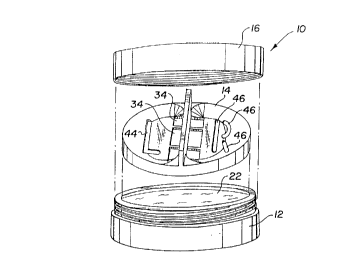Une partie des informations de ce site Web a été fournie par des sources externes. Le gouvernement du Canada n'assume aucune responsabilité concernant la précision, l'actualité ou la fiabilité des informations fournies par les sources externes. Les utilisateurs qui désirent employer cette information devraient consulter directement la source des informations. Le contenu fourni par les sources externes n'est pas assujetti aux exigences sur les langues officielles, la protection des renseignements personnels et l'accessibilité.
L'apparition de différences dans le texte et l'image des Revendications et de l'Abrégé dépend du moment auquel le document est publié. Les textes des Revendications et de l'Abrégé sont affichés :
| (12) Brevet: | (11) CA 2083133 |
|---|---|
| (54) Titre français: | ETUI POUR VERRES DE CONTACT |
| (54) Titre anglais: | CONTACT LENS CASE |
| Statut: | Réputé périmé |
| (51) Classification internationale des brevets (CIB): |
|
|---|---|
| (72) Inventeurs : |
|
| (73) Titulaires : |
|
| (71) Demandeurs : | |
| (74) Agent: | FINLAYSON & SINGLEHURST |
| (74) Co-agent: | |
| (45) Délivré: | 1999-09-21 |
| (86) Date de dépôt PCT: | 1992-03-18 |
| (87) Mise à la disponibilité du public: | 1992-09-19 |
| Requête d'examen: | 1996-05-14 |
| Licence disponible: | S.O. |
| (25) Langue des documents déposés: | Anglais |
| Traité de coopération en matière de brevets (PCT): | Oui |
|---|---|
| (86) Numéro de la demande PCT: | PCT/US1992/002241 |
| (87) Numéro de publication internationale PCT: | WO1992/016123 |
| (85) Entrée nationale: | 1992-11-17 |
| (30) Données de priorité de la demande: | ||||||
|---|---|---|---|---|---|---|
|
Boîtier de rangement (10) pour verres de contact, comprenant un récipient (12) contenant la solution liquide (22), un plateau (14) s'adaptant à l'intérieur du récipient (12) et présentant une partie essentiellement plate (26) sur laquelle reposent les verres de contact et une partie annulaire oblique (30) qui ralentit le mouvement des verres vers l'extérieur. Une barre perpendiculaire de division (32) s'étend vers le haut depuis la partie supérieure du plateau (14) et permet à la fois de séparer le verre droit du verre gauche et, utilisée comme une poignée, de soulever le plateau (14). Ce dernier comporte des ouvertures (34) adjacentes à la barre ou à proximité immédiate de celle-ci, ainsi que d'autres ouvertures (44, 46) formant la lettre ''L'' d'un côté de la barre et la lettre ''R'' de l'autre côté. Un couvercle amovible (16) présente des nervures à l'intérieur, afin d'éviter la création d'une force d'aspiration entre ledit couvercle et le côté concave d'un verre.
A contact lens case (10) having a container (12) for
liquid solution (22), a tray (14) which fits into the container
(12) and having a substantially flat portion (26) for the
contact lens to rest on and an annular beveled outer portion
(30) for retarding the outward movement of the lens. A dividing
perpendicular bar (32) extending upwardly from the top of the
tray (14) and serves both to separate the right lens from the
left lens and to act as a handle for lifting the tray (14). The
tray (14) forms apertures (34) adjacent to or in near proximity
to the bar and other apertures (44, 46) to form the letter "L" on
one side of the bar and the letter "R" on the other side. A
removable cap (16) forms ridges on its inside to prevent the
creation of suction between it and the concave side of a lens.
Note : Les revendications sont présentées dans la langue officielle dans laquelle elles ont été soumises.
Note : Les descriptions sont présentées dans la langue officielle dans laquelle elles ont été soumises.

Pour une meilleure compréhension de l'état de la demande ou brevet qui figure sur cette page, la rubrique Mise en garde , et les descriptions de Brevet , États administratifs , Taxes périodiques et Historique des paiements devraient être consultées.
| Titre | Date |
|---|---|
| Date de délivrance prévu | 1999-09-21 |
| (86) Date de dépôt PCT | 1992-03-18 |
| (87) Date de publication PCT | 1992-09-19 |
| (85) Entrée nationale | 1992-11-17 |
| Requête d'examen | 1996-05-14 |
| (45) Délivré | 1999-09-21 |
| Réputé périmé | 2004-03-18 |
Il n'y a pas d'historique d'abandonnement
| Type de taxes | Anniversaire | Échéance | Montant payé | Date payée |
|---|---|---|---|---|
| Le dépôt d'une demande de brevet | 0,00 $ | 1992-11-17 | ||
| Taxe de maintien en état - Demande - nouvelle loi | 2 | 1994-03-18 | 50,00 $ | 1994-03-18 |
| Taxe de maintien en état - Demande - nouvelle loi | 3 | 1995-03-20 | 50,00 $ | 1995-03-16 |
| Taxe de maintien en état - Demande - nouvelle loi | 4 | 1996-03-18 | 50,00 $ | 1996-03-12 |
| Enregistrement de documents | 0,00 $ | 1996-05-30 | ||
| Taxe de maintien en état - Demande - nouvelle loi | 5 | 1997-03-18 | 75,00 $ | 1997-03-17 |
| Taxe de maintien en état - Demande - nouvelle loi | 6 | 1998-03-18 | 75,00 $ | 1998-03-11 |
| Taxe de maintien en état - Demande - nouvelle loi | 7 | 1999-03-18 | 75,00 $ | 1999-03-15 |
| Taxe finale | 150,00 $ | 1999-06-15 | ||
| Taxe de maintien en état - brevet - nouvelle loi | 8 | 2000-03-20 | 75,00 $ | 2000-02-16 |
| Taxe de maintien en état - brevet - nouvelle loi | 9 | 2001-03-19 | 275,00 $ | 2002-03-18 |
| Taxe de maintien en état - brevet - nouvelle loi | 10 | 2002-03-18 | 100,00 $ | 2002-03-18 |
Les titulaires actuels et antérieures au dossier sont affichés en ordre alphabétique.
| Titulaires actuels au dossier |
|---|
| IVES IDEAS, INC. |
| Titulaires antérieures au dossier |
|---|
| IVES, RAY C. |